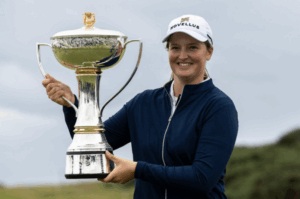Reflections on Shadowing a Sports and Exercise Medicine Doctor in Elite Women’s Golf
Introduction
Given Sports and Exercise Medicine (SEM) is not currently a specialty offered in the UK Foundation Programme rotations, clinical experience must be gained during ‘taster’ days or during days off. I am very grateful to Professor Andrew Murray and Dr Emma Lunan for giving me the opportunity to shadow Dr Lunan, a SEM consultant, at the 2025 ISPS HANDA Scottish Women’s Open 2025. This built on my experiences at the St Andrews, Carnoustie and Kingsbarns Golf Links in 2024.

Whilst I have completed a MSc SEM and the FSEM membership exams by independent study, my aim whilst shadowing was to gain insight into the day-to-day reality of an elite SEM doctor’s role. Not only is this vital in order to develop safe and competent clinical practice, but it is also an exciting opportunity to get hands on using my knowledge and skills. Learning from Dr Lunan about the combination of clinical, organisational and interpersonal skills required was invaluable and confirmed that this is a career I will continue working towards.
Treating the Team
Given elite female golfers frequently travel the globe, alongside medical emergencies the SEM doctor routinely manages primary care presentations including infection, allergy, analgesic management and poor mental health. On certain days, a tournament may also employ on-site consultants in relevant specialities, including:
- Psychiatry
- Gynaecology
- Radiology.
The players’ presentations are predominantly musculoskeletal (MSK) in origin, namely those flagged by physiotherapists for potential further investigation or surgical referral. Dr Lunan’s point-of-care ultrasound (USS) skills facilitated rapid diagnosis and management. On-site magnetic resonance imaging (MRI) was also provided on one day. On-site imaging helpfully facilitates investigation with minimal disruption to players’ schedules during a high-pressure tournament week. This informs whether they can safely compete or if withdrawing is advised, with potentially significant impacts on their sporting performance, earnings and health.
Presentations diagnosed by USS included:
- De Quervain’s tenosynovitis
- Triangular fibrocartilage complex (TFCC) injury
- First metatarsophalangeal joint osteoarthritis.
This has prompted me to undertake an MSK ultrasound skills course in future, to improve my competency in this vital skill as an SEM doctor.
However, the SEM doctor’s duty of care extends beyond the players. Care is routinely provided to players’ teams (for example, coaches and family members) and tournament staff. Presentations range from occupational illness or injury, stress and burnout or (similarly to players) primary care presentations for those travelling frequently. Although most cases are managed on-site, as in a GP practice certain patients require onward referral; for example, Dr Lunan referred a suspected (and later confirmed) posterior vitreous detachment to local ophthalmology services for appropriate specialist management. Moreover, whilst spectators are primarily reviewed by paramedics and first-aiders, in the event of any medical emergency the doctor is also part of the immediate response team.
Logistics, Liaison and Leadership
Of note, Dr Lunan highlighted the doctor’s responsibility to instigate logistical operations in the event of infection outbreak, to minimise spread in a densely-populated player environment. She also emphasised the importance of considering medicolegal and anti-doping regulations when prescribing medications to players, to minimise the impact of this on their ability to participate in competition. Furthermore, maintaining patient confidentiality is crucial, both to build a trusting patient-doctor relationship and ensure that a high standard of ethical practice is upheld. A common misconception is that players automatically share healthcare information with their teams; however, the elite sporting context does not negate the requirement for explicit consent for information sharing with named individuals.

I was fortunate to spend time learning from multiple members of the multi-disciplinary team, including:
- Physiotherapy
- Massage therapy
- First aid
- Paramedics
- Player liaison officers.
The importance of clear communication between teams was evident. I learned the importance of pre-emptively performing radio and equipment checks and learning the golf course layout, to minimise potential barriers to effective teamwork and patient care in time-sensitive situations. Even learning the road map and how to drive a golf buggy proved to be important skills to learn in the event of a medical emergency on the course. Additionally, observing the multilingualism of an international sports event reiterated the benefits of speaking multiple languages in a professional capacity in elite sport. As a fluent German and proficient French speaker, this experience has prompted me to revise medical and sporting terminology in these languages, to expand my international opportunities as a SEM doctor in the future.
Conclusion
Shadowing Dr Lunan gave me exciting and valuable insight into the reality of working as a SEM doctor at an elite female golfing sporting event. This experience highlighted key areas for continuing my professional development:
- Gain competency in MSK USS skills
- Enhance my sports medicine-specific multilingualism to widen future opportunities
- Continue seeking out clinical SEM experience in a variety of settings
Many thanks once again to all the players and staff members who facilitated this experience.
Author names & affiliations:
Dr Isabelle Schlegel, Foundation Year 2 Trainee (NHS Ayrshire and Arran)
Dr Emma Lunan, Consultant Sport and Exercise Medicine.
Photos credited to the Media Information Team at the ISPS HANDA Women’s Scottish Open.